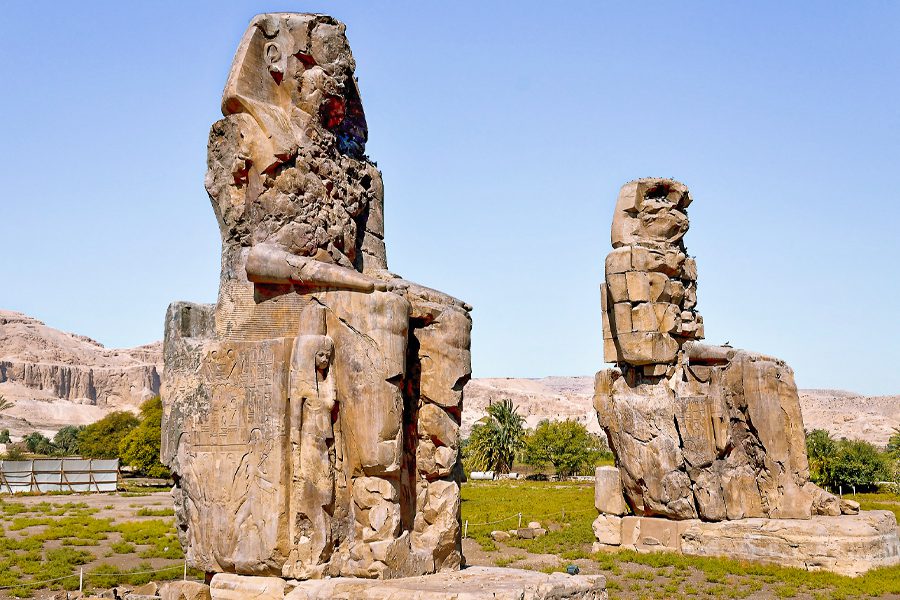

The Colossi of Memnon: Guardians of Ancient Thebes
The Colossi of Memnon stand as silent sentinels on the West Bank of the Nile near Luxor, Egypt. These two massive stone statues have captivated visitors for centuries, drawing them into the mysteries of ancient Egyptian history. Despite their weathered appearance, the Colossi remain a testament to the grandeur of the pharaohs and the architectural prowess of the ancient Egyptians.
Colossi of Memnon :A Brief History
Origins and Purpose
The Colossi of Memnon were originally constructed during the reign of Pharaoh Amenhotep III, around 1350 BCE. They were part of a larger mortuary temple complex dedicated to the pharaoh, who was one of Egypt’s most powerful rulers. The temple itself was one of the largest ever built in Egypt, although little of it remains today due to destruction from floods and other natural events.
The Statues
Each statue stands approximately 18 meters (59 feet) tall and weighs an estimated 720 tons. Carved from blocks of quartzite sandstone, they depict Amenhotep III seated on a throne, with his hands resting on his knees. The sides of the thrones are adorned with carvings of his mother, Mutemwiya, and his wife, Tiy, alongside depictions of the Nile god Hapi.
Legend of Memnon
The Singing Statues
In ancient times, the northern statue was famously known for producing a mysterious sound at dawn, which was likened to singing. This phenomenon was believed to be the voice of Memnon, a hero of the Trojan War, calling to his mother, Eos, the goddess of dawn. The Greeks associated the statues with Memnon due to their belief in th
e interconnectedness of myth and reality.
Scientific Explanation
The “singing” was likely caused by the temperature difference between the cool night air and the warming rays of the morning sun, which caused the stone to expand and emit a sound. This phenomenon ceased after the statues were restored by the Roman Emperor Septimius Severus in 199 CE.
Architectural Significance
Engineering Feats
The construction of the Colossi of Memnon is a testament to the engineering capabilities of the ancient Egyptians. Transporting the massive stone blocks from the quarries near Cairo to Luxor, a distance of over 600 kilometers (373 miles), would have required immense logistical planning and manpower.
Artistic Details
Despite their size, the statues are intricately detailed. The carvings on the thrones reflect the artistic skill and attention to detail that characterized ancient Egyptian art. These details offer insights into the cultural and religious beliefs of the time, emphasizing the divine nature of the pharaoh.
Visiting the Colossi of Memnon
Location and Accessibility
The Colossi of Memnon are located near the modern city of Luxor, accessible by road from the city center. They are a popular stop on tours of the West Bank, which also include visits to the Valley of the Kings and the Temple of Hatshepsut.
Best Time to Visit
The best time to visit the Colossi is during the cooler months from October to April. Early morning visits are ideal, not only to avoid the crowds but also to experience the statues in the soft light of dawn, reminiscent of the times when they were believed to “sing.”
TheColossi of Memnon Today
Preservation Efforts
Ongoing preservation efforts aim to protect the Colossi of Memnon from further degradation. These efforts include structural stabilization and protection from environmental factors such as wind and water erosion.
Cultural Impact
The Colossi of Memnon continue to inspire awe and curiosity, drawing visitors from around the world. They serve as a powerful reminder of the enduring legacy of ancient Egypt and its influence on art, architecture, and mythology.
Conclusion
The Colossi of Memnon are more than just statues; they are enduring symbols of ancient Egyptian civilization. Their imposing presence and rich history offer a glimpse into a world that has long fascinated historians and travelers alike. Whether you’re an avid history buff or a curious traveler, a visit to these monumental statues is sure to be a highlight of your journey through Egypt
Recent Posts
Edfu Temple :5 Reasons to Explore the Majestic Today
Discover 7 Amazing Features of Sinbad Hotel Egypt for 2024
Top 7 Reasons to choose Egypt Air Hospital in Egypt
All Categories
Tags


Thailand







